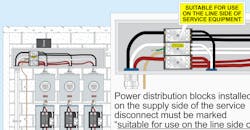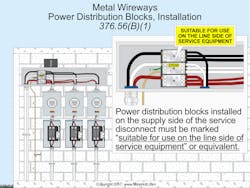All questions and answers are based on the 2017 NEC.
Underline text indicates a Code change.
Q. What is the NEC limit on the number of conductors and cables that are allowed to be installed in a wireway?
A. The maximum number of conductors or cables permitted in a wireway is limited to 20% of the cross‑sectional area of the wireway [Sec. 376.22(A)].
Splices and taps must not fill more than 75% of the wiring space at any cross section [Sec. 376.56].
Q. Under what conditions does the Code allow luminaires to be installed in commercial cooking hoods?
A. Luminaires can be installed in commercial cooking hoods if all the following conditions are met [Sec. 410.10(C)]:
(1) The luminaire is identified for use within commercial cooking hoods.
(2) The luminaire is constructed so that all exhaust vapors, grease, oil, or cooking vapors are excluded from the lamp and wiring compartment.
(3) The luminaire is corrosion resistant, or protected against corrosion, and the surface must be smooth so as not to collect deposits and to facilitate cleaning.
(4) Wiring methods and materials supplying the luminaire aren’t permitted to be exposed within the cooking hood.
Standard gasketed luminaires aren’t permitted to be installed in a commercial cooking hood because accumulations of grease and oil can result in a fire caused by high temperatures on the glass globe.
Q. What does the Code require when installing splices, taps, and power distribution blocks in a metal wireway?
A. Splices and taps in metal wireways must be accessible, and they must not fill the wireway to more than 75% of its cross‑sectional area [Sec. 376.56(A)].
The maximum number of conductors permitted in a metal wireway is limited to 20% of its cross‑sectional area at any point [Sec. 376.22(A)].
Power distribution blocks installed in wireways must be listed; if installed on the supply side of the service disconnect, they must be marked “suitable for use on the line side of service equipment” or equivalent [Sec. 376.56(B)(1)], as shown in the Figure.
In addition to the wiring space requirements [Sec. 376.56(A)], the power distribution block must be installed in a metal wireway not smaller than specified in the installation instructions of the power distribution block [Sec. 376.56(B)(2)].
Wire‑bending space at the terminals of power distribution blocks must comply with Sec. 312.6(B) [Sec. 376.56(B)(3)].
Power distribution blocks must not have uninsulated exposed live parts in the metal wireway after installation, whether or not the wireway cover is installed [Sec. 376.56(B)(4)].
Conductors must be installed so that the terminals of the power distribution block aren’t obstructed [Sec. 376.56(B)(5)].
Q. What is the NEC definition of closet storage space, regarding luminaires?
A. As noted in Sec. 410.2, storage space is defined as a volume bounded by the sides and back closet walls, extending from the closet floor vertically to a height of 6 ft or the highest clothes-hanging rod at a horizontal distance of 2 ft from the sides and back of the closet walls. Storage space continues vertically to the closet ceiling for 1 ft or the width of the shelf, whichever is greater.
This definition consists of approximately 125 words in one sentence, perhaps the longest sentence in the Code. Take a breath, and don’t get lost while reading it.
olt is the owner of Mike Holt Enterprises, Inc. in Leesburg, Fla. He can be reached at www.mikeholt.com.About the Author

Mike Holt
Mike Holt is the owner of Mike Holt Enterprises (www.MikeHolt.com), one of the largest electrical publishers in the United States. He earned a master's degree in the Business Administration Program (MBA) from the University of Miami. He earned his reputation as a National Electrical Code (NEC) expert by working his way up through the electrical trade. Formally a construction editor for two different trade publications, Mike started his career as an apprentice electrician and eventually became a master electrician, an electrical inspector, a contractor, and an educator. Mike has taught more than 1,000 classes on 30 different electrical-related subjects — ranging from alarm installations to exam preparation and voltage drop calculations. He continues to produce seminars, videos, books, and online training for the trade as well as contribute monthly Code content to EC&M magazine.


